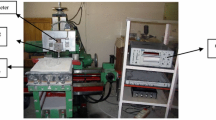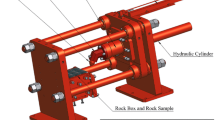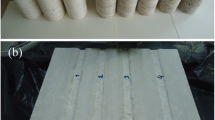Abstract
Full-scale laboratory cutting tests that measure the specific energy (SE) are widely used to evaluate rock cuttability by mechanical excavators, and in particular roadheaders fitted with radial or drag-type bits. Radial or drag-type bits are often changed during operation as they wear and become blunt. In this study, full-scale cutting tests were carried out on different rock types using bits with varying degrees of wear in order to assess the impacts of pick bluntness on cutting forces and the SE. The relationships between wear flats and cutting forces, SE, and various rock properties such as uniaxial compressive strength, tensile strength, indentation index, Shore hardness, Schmidt hammer hardness, and density were examined and are discussed in this paper. The mean cutting force increased 2- to 3-fold and the cutting SE rose 4- to 5-fold with a 4-mm wear flat as compared to a sharp pick. Critical wear flats were plotted for different rock property values, and 25 MJ/m3 was considered the threshold SE above which cutting performance was considered to be poor. Best-fit predictive models based on statistical analysis of the laboratory cutting test results are introduced as a means to estimate SE as a function of bit type, wear condition, and various mechanical properties of the rock. These models can be used to predict the performances of mechanical excavators that use radial tools, especially roadheaders, continuous miners, and longwall drum shearers.
Résumé
Les tests de découpe à grande échelle, permettant de mesurer l'énergie spécifique (ES), sont largement employés en laboratoire afin d'évaluer l'aptitude à la découpe des roches par excavatrices mécaniques, notamment les haveuses montées avec des trépans racleurs rotatifs ou radiaux Ces derniers doivent être changés régulièrement lors des expériences du fait de leur usure par épointement. Dans cette étude, les tests ont été réalisés sur différents types de roches, en utilisant des pics présentant divers degrés d'usure, et ce dans le but d'estimer l'effet de l’épointement sur les forces de coupe et sur l'ES. Les relations entre plat d'usure, force de coupe, ES et de nombreuses propriétés des roches (telles que dureté Shore, dureté Schmidt Hammer et densité) font l’objet de cet article. En comparaison de celles obtenues avec une pointe aiguisée, les forces moyennes de coupe avec une pointe usée (plat de 4 mm) ont été multipliées par un facteur de 2 à 3, et l'ES de coupe par un facteur de 4 à 5. Il est alors possible de tracer les valeurs critiques de plat d'usure pour différentes propriétés des roches. Les performances de coupe sont considérées comme pauvre en dessous d'un seuil d'ES de 25 MJ/m3. Des modèles de régression basés sur une analyse statistique des résultats de coupes en laboratoire permettent alors d'estimer l'ES en fonction du type de pic, de la condition d'usure, ainsi que de nombreuses propriétés mécaniques de roches.








Similar content being viewed by others
References
Atkinson T, Cassapi VB, Singh RN (1986) Assessment of abrasive wear resistance potential in rock excavation machinery. Int J Min Geol Eng 4(2):151–163
Balci C, Bilgin N (2005) Comparison of small and full scale rock cutting tests to select mechanized excavation machines. İstanbul Technical University, Mining Engineering Department
Balci C, Demircin MA, Copur H, Tuncdemir H (2004) Estimation of optimum specific energy based on rock properties for assessment of roadheader performance. J S Afr Inst Min Metall 104:633–642. ISSN 0038–223X/3.00
Bilgin N, Yazici S, Eskikaya Ş (1996) A model to predict the performance of roadheaders and impact hammers in tunnel drivages. In: EUROCK’96, Torino, Italy, 2–5 Sept 1996, pp 710–721
Bolukbasi N (1973) Studies on the design and operation of some longwall mining systems using a 1/4 scale model. Ph.D. thesis. University of Newcastle upon Tyne, Newcastle upon Tyne
Bolukbasi N (1989) Indication of excavation capability for A.O.L. Beypazarı region rocks. Mining Engineering Department, Middle East Technical University, Ankara
Çopur H, Ozdemir L, Rostami J (1998) Roadheader applications in mining and tunneling industries. Min Eng (March):38–42
Dalziel JA, Davies E (1964) Initiation of cracks in coal specimens by blunted wedges. The Eng 217:217–220
Dogruoz C (2010) Effect of pick blunting on cutting performance for weak–moderate rocks. Ph.D. thesis. Mining Engineering Department, Middle East Technical University, Ankara
Evans I (1974) Relative efficiencies of picks and discs for cutting rocks. Fairhurst C, Wallace GB (eds) Advances in rock mechanics: proceedings of the Third ISRM Congress of the International Society for Rock Mechanics, vol.2-B. Natl Acad Sci, Washington, DC, p 1399
Evans I (1984) A theory of the cutting force for point attack picks. Int J Min Eng 2:63–71
Evans I, Pomeroy CD (1966) The strength, fracture and workability of coal. Pergamon, London
Fowell RJ (1973) Studies on the application of percussively activated tools to reef slotting in some South African quartzites. Ph.D. thesis. University of Newcastle upon Tyne, Newcastle upon Tyne
Fowell RJ, Johnson ST (1982) Rock classification and assessment for rapid excavation. In: Proc Symp Strata Mech, Newcastle upon Tyne, UK, 5–7 April 1982, pp 241–244
Fowell RJ, Pycroft AS (1980) Rock machinability studies for the assessment of selective tunnelling machine performance. In: Proc 21st Natl Rock Mechanics Symp, Rolla, MO, USA, 28–30 May 1980, pp 149–158
Fowell RJ, Pycroft AS (1982) Rock machineability studies for the assessment of the selective tunneling. Elsevier, Newcastle upon Tyne, pp 241–244
Fowell RJ, Richardson G, Gollick MJ (1994) Prediction of boom tunnelling machine excavation rates. In: Nelson PP, Laubach SE (eds) Rock mechanics: models and measurements; challenges from industry. A.A. Balkema, Rotterdam, pp 243–51
Gehring KH (1989) A cutting comparison. Tunn Tunn 21:27–30
Goktan RM, Gunes N (2005) A comperative study of Schmidt hammer testing procedure with reference to rock cutting. Int J Rock Mech Min Sci 42:466–472
Keles S (2005) Cutting performance assessment of a medium weight roadheader at Çayırhan coal mine. M.Sc. thesis. Middle East Technical University, Ankara, p 58
Kenny P, Johnson SN (1976) The effect of wear on the performance of mineral-cutting tools. Collie Guard: 224–246
McFeat-Smith I (1975) Correlation of rock properties and tunnel machine performance in selected sedimentary rocks. Ph.D. thesis, University of Newcastle upon Tyne, Newcastle upon Tyne
McFeat-Smith I, Fowell RJ (1976) Factors influencing the cutting performance of a selective tunnelling machine. Proc Tunnelling Symp, 76. Department of Mining Engineering, University of Newcastle upon Tyne, Newcastle upon Tyne, p 301
McFeat-Smith I, Fowell RJ (1977) Correlation of rock properties and the cutting performance of tunnelling machines. Proc Conf on Rock Eng, Newcastle upon Tyne, UK, 4–7 April 1977, p 581
McFeat-Smith I, Fowell RJ (1979) The selection and application of roadheaders for rock tunnelling. In: RETC (Rapid Excavation and Tunnelling Conference) proceedings, vol 1. New York, pp 262–279
Neil DM, Rostami J, Ozdemir L, Gertsch R (1994) Production estimating techniques for underground mining using roadheaders. SME/AIME Annual Meeting, Albuquerque, NM, USA, 14–17 Feb 1994
Rostami J, Ozdemir L, Neil DM (1994) Application of heavy duty roadheaders for underground development of the Yucca Mountain Exploratory Study Facility. Proc Int High Level Nuclear Waste Management Conf, Las Vegas, NV, USA, 17–20 May 1994
Rostami J, Monroe S, Ozdemir L (1998) Issues related to design and performance optimization of continuous for increased productivity. In: SME/AIME 1998 Annual Meeting & Exhibit, Orlando, FL, USA, 9–11 March 1998 (preprint no. 98–218)
Roxborough FF, Phillips HR (1974) Experimental studies on the excavation of rocks using picks. In: Fairhurst C, Wallace GB (eds) Advances in rock mechanics: proceedings of the Third ISRM Congress of the International Society for Rock Mechanics. Natl Acad Sci, Washington, DC
Thuro K, Plinninger RJ (1999) Roadheader excavation performance: geological and geotechnical influences. In: 9th ISRM Congress (Theme 3: Rock Dynamics and Tectonophysics/Rock Cutting and Drilling), Paris, France, 25–28 Aug 1999
Author information
Authors and Affiliations
Corresponding author
Rights and permissions
About this article
Cite this article
Dogruoz, C., Bolukbasi, N. Effect of cutting tool blunting on the performances of various mechanical excavators used in low- and medium-strength rocks. Bull Eng Geol Environ 73, 781–789 (2014). https://doi.org/10.1007/s10064-013-0551-y
Received:
Accepted:
Published:
Issue Date:
DOI: https://doi.org/10.1007/s10064-013-0551-y




